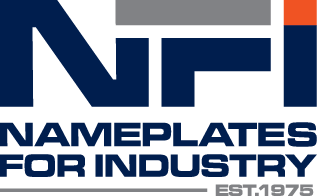Are You Stuck?
Have you ever not noticed something that’s right there in front of you? We all have. Some of the most common items that go unnoticed are labels and stickers. They are EVERYWHERE---on our televisions, inside our refrigerators and our washers and dryers. As consumers, we typically only pay attention to them when we need them, especially when we place service calls or look for instruction. As a manufacturer, your label responsibility is broader. You not only have to be mindful of what is printed on the label, but also what is stuck to its back as the wrong adhesive can impair your graphic’s visual aspect, rendering your label useless.
So how do you know what type of adhesive you need for your product or equipment part label? There are various factors to consider. It’s kind of a long list for something so obsequious, but here it goes anyway…
Consider the surface that the label must adhere to. Is it oily? How thick or thin is it? What is its shape (e.g. flat or round)? Is its texture smooth or rough? WARNING (which by the way, is a common label in itself): If the surface is oily, you’ll need an adhesive that is developed specifically for that application as oil and typical adhesives are natural enemies---just another challenge for the transportation industry as they develop their engine parts and hydraulics. The bottom line is, your label adhesives must accommodate your product surface area. And remember to always wipe your product surface clean to ensure best label adhesion.
Focus on regulation(s). Your label performance must be compliant on your various products and equipment parts’. For example, if your label needs to adhere long-term and, at the same time, be removable, you’ll need to ensure the right adhesive is used to achieve that type of performance. (We respectfully advise television manufacturers to add label adhesion to your list of industry compliance challenges.)
Think about your label’s multiple environments. Will your labels be exposed to chemicals and multi-user handling (e.g. graphic overlays, keypads and faceplates on medical equipment and electronics, etc.)? Do they need to withstand water and heat conditions (e.g. safety and instruction labels for marine and auto equipment)? Provide your graphic solutions provider with all of the environmental concerns you have for your products and equipment parts, as they can negatively affect your label adhesive’s performance over time.
Build label adhesion timing into your product development schedule. Ask your graphics solutions supplier about adhesion time. Will your labels bond immediately after applied? Or does your graphic solutions provider advise a 24-hour wait time? Time is money so plan it wisely (or simply find a label vendor who is considerate of your time).
There are other adhesive considerations, including those used for high security applications. When you develop equipment or parts, especially for military or government use, your labels’ adhesives should indicate if they have been tampered with to alert your customer of potential security breaches. Serial numbers and barcodes are prime targets when it comes to security risk.
Permanent labels. Removable labels. Labels that need to withstand extreme environments. All of them need to be planned in conjunction with your product and equipment development. In many industries they are heavily regulated because they are considered critical components of product safety.
Some adhesive requirements may be easily identified, such as permanent and repositionable, but when it comes to specific adhesion needs, work with a graphic solutions vendor that is flexible in adhesion options, including those that can be developed specifically for your application. Rely on their expertise in various industries. An experienced label provider will most likely have your adhesion challenge(s) already resolved.
Following are the essential details you should arm your trusted label developer with when planning your graphic solutions:
- Surface construction
- Surface finish
- Environmental conditions for assembly
- Cleaning requirements (including which solvents are used)
- Required longevity of label adhesion
Working with the right vendor can save you time and money, help you keep on track with manufacturing uptime and compliance. Remember that your product and equipment labels need to perform far past your production doors, because their good performance adds great value to your brand.
Click HERE to Get a Free Sample Packet of our labels

